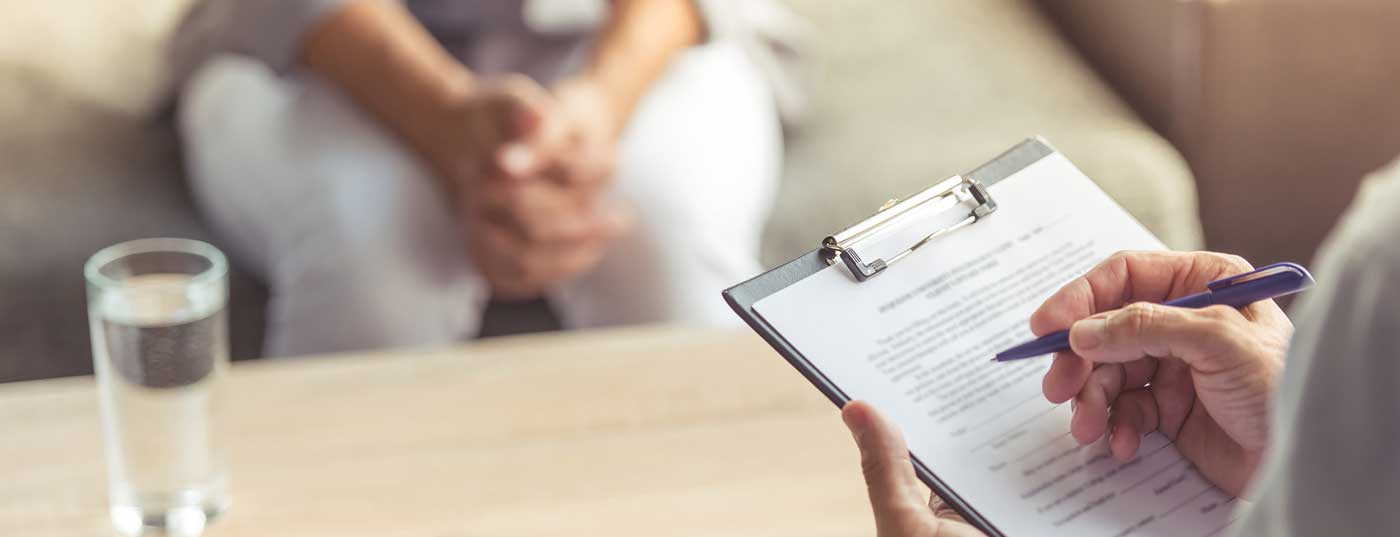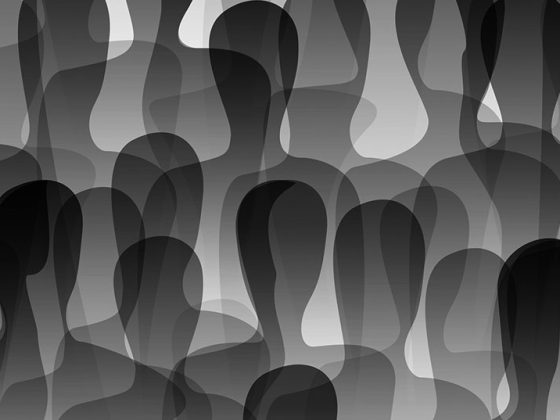Excessive sweating is a psychologically stressful symptom. There are empirical findings of an increased prevalence of depressive disorders and/or an anxiety problem in patients with primary hyperhidrosis. This should be taken into account in the diagnosis and treatment of affected individuals.
Unlike secondary hyperhidrosis, in the idiopathic subtype the profuse sweating is not a symptom of another disease, but the actual problem. Unpleasant sweat odor is caused by the interaction of different types of glands and bacteria of the skin flora and can be very distressing for sufferers. In contrast to secondary hyperhidrosis (e.g. due to a malfunction of the thyroid gland or a tumor leading to increased release of the stress hormone cortisol), the increased sweating in primary hyperhidrosis occurs locally. Predilection sites are the armpits, palms or soles of the feet – the sweat glands localized in the dermis occur here in particularly high numbers and density. The forehead and head may also be affected.
Stress – trigger factor and sequelae
In the pathomechanism, a functional disorder of the eccrine sweat glands plays an important role. Their activity is regulated by the autonomic nervous system, and a large proportion of diseases are due to increased activity of the sympathetic nerve. The cause of this increased nerve activity has not yet been clarified. The function of the sympathetic nervous system is resource mobilization (“fight or flight”); the release of acetylcholine increases the body’s readiness to perform in stressful situations. This is accompanied by a synchronous activation of the sweat glands. Frequently, increased sweating in the context of primary hyperhidrosis is triggered by stressful situations. Emotional stimuli such as tension, pain, fear and bias can play an important role in this. Since sweating is in turn itself a potential stress factor, a vicious circle can develop. Emotional and psychological stress, as well as social exclusion, often accompany hyperhidrosis. In addition to an unpleasant body odor, visible wetness of the affected skin areas is a typical feature of hyperhidrosis. This can lead to skin irritation, erythema and scaling. The constant moistening of the skin favors the growth of bacteria and fungi, which can lead to a so-called macerative foot infection or bromhidrosis.
The following tests have proven useful for the diagnosis of primary hyperhidrosis: The amount of sweat produced can be quantified by placing a filter paper on the affected area for a specified period of time and subsequently weighing the sweat absorbed [1]. Threshold values for hyperhidrosis are considered to be 20-30 mg sweat per minute for the palms and 50 mg per minute in the armpits, depending on the literature source [2]. Another option is the iodine strength test [1,2]. The affected skin area is visualized to estimate the size of the sweat-producing area. For this purpose, a 1.5% iodine solution is applied to the affected area and sprinkled with cereal starch after drying. In combination with sweat, a brown-purple colored iodine-starch complex is formed. Primary hyperhidrosis can also be diagnosed by exclusion procedures if no underlying disease is detected during the examinations.
Evidence of high levels of anxiety and depression
The results of the secondary analysis by the Danish research team [3] were published in the journal Acta Dermato Venereologica in December 2019. Most of the included studies measured an increased prevalence of anxiety disorders and depression, but the overall results were heterogeneous. The authors stated that the data base of controlled scientific studies on this topic is relatively small. The research team conducted a systematic search of the PubMed, Embase, and PsycINFO databases using predefined inclusion criteria. Only controlled studies in which validated screening instruments had been used were considered. Seven studies were included in the final analysis. The most important at a glance:
López-López et al (2019) [4]: In this study conducted in Spain in a sample of dermatological patients (n=100), 21% of subjects with hyperhidrosis met criteria for depressive disorder according to the BDI (p<0.001). Hyperhidrosis was classified using the Hyperhidrosis Disease Severity Scale (HDSS 2-4; n=45).
Li et al. (2018) [5]: This study from the United States found that in a collective of 106 patients with primary focal palmar hyperhidrosis, 17.6% suffered from an anxiety disorder and 16.7% from depression.
Bahar et al. (2016) [6]: Analysis of data from dermatology patients (n=2017) in Canada and China revealed that those affected by primary hyperhidrosis and “late onset hyperhidrosis” (n=437) were significantly more likely to have anxiety disorders and depression compared to those with other dermatology diagnoses (21.3% and 27.2% vs. 7.5% and 9.7%; p<0,001). Patients with generalized facial hyperhidrosis were the most affected.
Braganza et al (2014) [7]: A study of 197 patients in Brazil showed that anxiety disorders were significantly more common (49.6%) in individuals with primary hyperhidrosis, with those with axillary or facial hyperhidrosis suffering the most, but also affecting those with plantar or palmar symptoms.
Gross et al. (2014) [8]: In this study conducted in Germany, patients with hyperhidrosis (n=40) were compared with an age- and sex-matched control group (n=40). In the hyperhidrosis group, 60% were affected by depressive disorder (BDI) compared to 10% in the control group (p<0.002).
| Screening instrument HADS (Hospital Anxiety Depression Scale) Economical and feasible tool for screening anxiety and depression symptoms in clinical practice, especially in patients with physical illness or somatoform/functional complaints.
|
Which screening instrument?
According to the authors’ assessment, the HADS (Hospital Anxiety and Depression Scale) [9] is suitable for use for screening purposes in practice. It is a validated psychometric questionnaire available in German translation [10]. Anxiety and depression symptoms are assessed using 14 items (box). This allows a more practicable and reliable assessment of findings than through an exclusively anamnestic interview. The cost of this measurement tool is low. In particular, hyperhidrosis sufferers with depression and anxiety disorder are likely to have impaired quality of life. To measure quality of life, the authors suggest using the Skindex-16 are [11]. Consideration of any depression or anxiety disorder in the diagnosis and treatment of hyperhidrosis patients is recommended. According to the authors, however, it cannot be conclusively assessed on the basis of the studies analyzed whether a reduction in hyperhidrosis symptoms also leads to the disappearance of comorbid psychological symptoms or whether this requires depression-specific treatment.
Literature:
- AWMF: S1 Guideline 013-079: Definition and therapy of primary hyperhidrosis, as of 11/2017, www.awmf.org
- Derma.plus: Dermaportal dp GmbH, Excessive sweating (hyperhidrosis), Prof. Dr. Dietrich Abeck https://derma.plus/haut/hyperhidrosis/#diagnose-und-differentialdiagnose
- Kristensen JK, et al: Association of Primary Hyperhidrosis with Depression and Anxiety: A Systematic Review. Acta Derm Venereol. 2019 Dec 10. doi: 10.2340/00015555-3393. [Epub ahead of print]
- Lopez-Lopez D, et al: Relationship between depression scores and degree of skin perspiration: a novel cross-sectional study. Int Wound J 2019; 16: 139-143.
- Li DC, et al: Endoscopic thoracic sympathectomy for primary focal hyperhidrosis: impact on psycho-social symptomatology and psychotropic medication use. Eur J Cardiothoracic Surg 2018; 54: 904-911.
- Bahar R, et al: The prevalence of anxiety and depression in patients with or without hyperhidrosis. J Am Acad Dermatol 2016; 75: 1126-1133.
- Braganza GMG, et al: Evaluation of anxiety and depression prevalence in patients with primary severe hyperhidrosis. Ann Bras Dermatol 2014; 89: 230-235.
- Gross KM, et al: Elevated social stress levels and depressive symptoms in primary hyperhidrosis. PLoS One 2014; 9: e 92412.
- Zigmond AS, Snaith RP: The Hospital Anxiety and Depression Scale. Acta Psychiatr Scand 1983; 67: 361-370.
- Herrmann C, Buss U: Presentation and validation of a German version of the Hospital Anxiety and Depression Scale (HAD scale). A questionnaire to assess psychological well-being in patients with physical complaints. Diagnostica 1995; 40: 143-154.
- Both H, et al: Critical review of generic and dermatology-specific health-related quality of life instruments. J Invest Dermatol 2007; 127: 2726-2739.
HAUSARZT PRAXIS 2020; 15(3): 32-33











